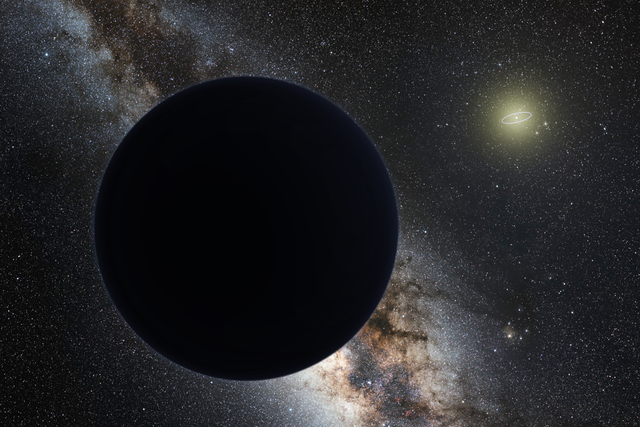Everyone has started to call this new proposed planet X: "Planet nine" as in the original announcement. Even Wikipedia has titled its article on it "Planet Nine". But it's a poor name for a planet if you think about it. Why not just call it "Planet X"? Or find some new name, like Nemesis and Tyche as was done for previous planet X candidates. None of the previous candidates for Planet X were called Planet + some number, and with good reason. There is no way that we can know it will be planet 9.
What if other planets are found closer to the sun? There's another proposed "Planet X" which orbits between 100 and 200 au from the sun to explain the "Kuiper cliff" which if it exists would be Mars or Earth sized. So what if we find this supposed "planet 9" and then find that planet?
And what if someone now comes up with another planet X. This is only the last of many, by no means proved, it may well fall into the dust of history and lead to another planet X.
Do we call the next one "planet 10"? Or should we number the planet X candidates sequentially, so Pluto is "Planet X 1", or maybe even Neptune is "Planet X 1", Pluto is "Planet X 2" - in a system like that it might well be "Planet X 9" but you'd get disagreements about how many candidate planet X's we've had so far that are distinctive enough to need a new number.
Also, if it exists, it's close to a borderline between a planet and a non planet according to the IAU definition. Somewhere between Mars, the weakest of the planets at clearing out its orbit, and Ceres, the strongest of the "dwarf planets" according to the IAU definition.

MARGOT'S Π
I've just been calculating Margot's Π - the various measures are all are in pretty good agreement in the discrimination between planets and non planets - and that's the only one that's easy to calculate. Very easy.
I'll indent the calculations so they are easy to skip.
With the planet measured in Earth masses, then m is 10. M is measured in solar masses, so is 1 of course as the sun is one solar mass. a is 700 au. And k for those units is 833. So the formula works out as
833*10/((700^(9/8) = 5.247
Where the value needs to be greater than 1 to "clear the neighbourhood".
So Margot's Π for the new planet is around 5.25.
By comparison Margot's discriminant for Mars is 54, the most weakly clearing of all the recognized planets. And of Mercury is 140.
An Earth mass planet in a similar orbit would have Margot discriminant a tenth of that, of 0.5247 and so would not be a planet according to Margot's discriminant.
Also a 10 Earth mass planet in an orbit with semi major axis 4000 au would not count as a planet because its Margot discriminant is 0.7385.
So it's a pretty close thing. Almost "too close to call" until we find out more. It might depend which discriminant you use.
UPDATE - most recent paper has semimajor axes of ~380–980 AU, and masses of ~5–20 Earth masses, which makes Margot's Π just a little over 1 at 833*5/(980^(9/8)) =1.79674179626
SOTER'S µ
Then, Soter's µ is based on empirical measurements. So, with a borderline case like this one might be, it might easily be years or decades before you have done a sufficiently complete inventory of the matter for the region it orbits through to decide whether it's a planet or not according to the definition.
SIMILAR MOTIVATIONS
They are all based on similar physical ideas.So with a system in equilibrium like ours, you'd expect reasonable agreement.
NOT SWEEPING TOTALLY CLEAN
It's not a matter of sweeping it completely clean.
In case of Earth, then anything in an orbit similar to ours gets cleared out within about twenty million years. Though there are numerous near Earth asteroids, every single one will get cleared out, either thrown towards the sun, Jupiter, ejected from the solar system or hit Earth, the Moon, Venus or Mars, or some such. But twenty million years is a long time and only a percentage of them will ever hit Earth.This near Earth region is getting constantly supplied by comets or asteroids or it would get completely cleared out.
COMPARISION TABLE OF THE VARIOUS MEASURES (FROM WIKIPEDIA)
In the table here Mars is worst of all the planets for clearing its orbit - and it gets hit by about ten times as many meteorites as Earth. Still there's quite a big jump down to Ceres, next best after Mars.
If this planet exists it will go somewhere between Mars and Ceres in that table.
WHAT HAPPENS WHEN WE FIND PLANETS "IN THE GAP" BETWEEN CERES AND MARS IN ORBIT CLEARING ABILITY?
Suppose for instance they don't find just one Neptune sized planet, but several Earth sized objects in resonant orbits? Are they planets? After all they wouldn't have cleared each other out of their orbits.
Or they find that the Neptune as expected, but also an Earth mass object in a resonant orbit of some kind. Is the Earth mass object a planet?
And what if some of the discriminants make it a planet and some don't?
PLANETS IN HYDROSTATIC EQUILIBRIUM
I'm strongly in favour of calling anything a planet if it is in hydrostatic equilibrium under gravity. Easy thing, you can tell that it's a planet as soon as you know its shape.
This doesn't just mean "nearly round" planets as in the IAU definition but also triaxial ellipsoids like Haumea, and over contact binaries if we find those as well, rocheworld scenarios. They'd all be planets because they are in hydrostatic equilibrium.
GIANTS AND DWARFS - AND UBER PLANETS
And then our planet has giant planets like Jupiter, and Neptune, dwarf planets like Earth and Mercury and sub dwarf planets like Ceres, Pluto, Sedna etc.
And then can refer to uber and unter planets for the clearing out the orbit, as Alan Stern suggested in his original paper. Or any other names, but just use a separate dedicated name for this concept.
That way we can have dwarf planets that are either uber or unter - clear or don't clearer, and giant planets can be also like a Venn diagram.
And then we can subdivide the planets up as we like - giant, dwarf, subdwarf, sub sub dwarf, and slice them any way we like without having to worry about whether they are clearing their neighbourhood or not.
Then we can use other words for asteroids on borderline between asteroids and dwarf (or sub dwarf) planets, such as planetoids, say.
EXAMPLES
So Vesta for instance would be a planetoid.
Ceres would be a dwarf unter planet.
Mercury is a dwarf uber planet
Pluto is a dwarf unter planet. So also are Sedna and all the other dwarf planets discovered recently.
Neptune is a giant uber planet
f you want a more precise term, Alan Stern suggested calling Earth, Mercury, Venus and Mars dwarf planets, and Pluto, Ceres, Eris etc "sub dwarf" planets. See Page on swri.edu
Alan Stern's suggestion is to call Earth and Venus, Mars, Mercury - the planets to the left of the picture, dwarfs.
Then he would call the really tiny Pluto, Charon, KBO objects etc, to the right of the picture, sub dwarfs.
But they are all planets. Image from: Illustrations - Roberto Ziche
Then the Kuiper cliff Planet X if it exists, Mars or Earth sized, would be a dwarf uber or unter planet depending on whether it is able to clear its orbit.
SO THEN IT CAN BE A GIANT PLANET WHETHER IT IS UBER OR UNTER
And this new object will be a giant planet (not a dwarf, and definitely a planet). We'll be able to say this right away just as soon as we know its mass.
But we might not be sure for some time whether it is uber or unter.
And won't have this absurd (seems to me) situation where a planet has to be referred to as a "dwarf planet" and not a planet if it doesn't clear its neighbourhood. That has nothing to do with the way "dwarf" is usually understood and it doesn't help with understanding, its unintuitive. Surely whether a planet is a dwarf or not has to depend on its mass?
And even more so when you then go on to say that it is also not a planet. How can a dwarf planet not be a planet?
With the IAU definition you have tiny Mercury which counts as a planet - and you could have a planet the size of Jupiter that has to be called a dwarf planet if it is way out in the Oort cloud. and in that situation then the Jupiter would be a dwarf planet and not a planet, and the Mercury would be a proper planet and not a dwarf.!
It works so far mainly because the planets so far discovered that clear their neighbourhood also happen to be large and the ones that don't are all small.
IAU CAN CHANGE ITS MIND
What if the IAU changes its definition again, as many astronomers are asking it to do - to call Ceres and Pluto both planets as well - then it would become planet 11 or maybe some higher number, to take account of dwarf planets closer to the sun than Pluto such as Orcus, etc and Neptune would be planet 9.
It sounds to me like a name from a sci. fi. story, we never call Earth "Planet 3" :).
People know what you mean if you say "planet nine" so it's become something of a "fait accomplis". Not sure if it can be changed unless someone comes up with some other more memorable name for it.
Names matter, they help to lead to clear thinking.
This is not to deny in any way that its proponents are brilliant astronomers! I just wish they'd thought of a better name for their proposed planet X. Like Nemesis, or Tyche - those were good names.
ANY THOUGHTS ABOUT A BETTER NAME FOR IT?
If you have any ideas for a better name, do say in the comments :).
SEE ALSO
See also my
This originated as my answer to the Quora question: Is it clear whether the putative "ninth planet" has cleared its neighbourhood?
MORE ONLINE POSTS AND LINK TO MY AUTHOR'S PAGE
And you might like my other posts on Quora

Robert Walker's posts - on Quora
And on Science20

Robert Walker's posts on Science20
KINDLE BOOKSHELF ON MY AUTHOR'S PAGE
And I have many other booklets on my kindle bookshelf My kindle books author's page on amazon




Comments